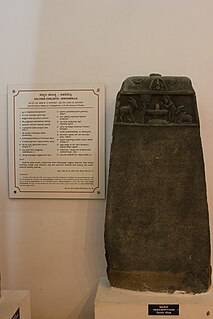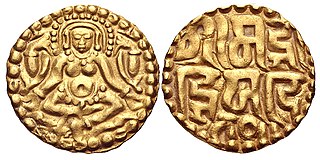Related Research Articles

The Kakatiya dynasty was a Indian dynasty that ruled most of eastern Deccan region comprising present day Telangana and Andhra Pradesh, and parts of eastern Karnataka and southern Odisha between 12th and 14th centuries. Their capital was Orugallu, now known as Warangal. Early Kakatiya rulers served as feudatories to Rashtrakutas and Western Chalukyas for more than two centuries. They assumed sovereignty under Prataparudra I in 1163 CE by suppressing other Chalukya subordinates in the Telangana region. Ganapati Deva significantly expanded Kakatiya lands during the 1230s and brought under Kakatiya control the Telugu-speaking lowland delta areas around the Godavari and Krishna rivers. Ganapati Deva was succeeded by Rudrama Devi and is one of the few queens in Indian history. Marco Polo, who visited India some time around 1289–1293, made note of Rudrama Devi's rule and nature in flattering terms. She successfully repelled the attacks of Yadavas (Seuna) of Devagiri into the Kakatiyan territory.

Rashtrakuta was a royal Indian dynasty ruling large parts of the Indian subcontinent between the sixth and 10th centuries. The earliest known Rashtrakuta inscription is a 7th-century copper plate grant detailing their rule from Manapura, a city in Central or West India. Other ruling Rashtrakuta clans from the same period mentioned in inscriptions were the kings of Achalapur and the rulers of Kannauj. Several controversies exist regarding the origin of these early Rashtrakutas, their native homeland and their language.

Lakkundi, also referred to as Lokkugundi, was a major city prior to the 14th-century, and is now a village in Gadag District of Karnataka, India. By 10th-century, it was already a major economic and commerce center with mint operations for South India, one mentioned in Kannada and Sanskrit inscriptions and texts. By 12th-century, a galaxy of Hindu and Jain temples had been consecrated here, along with public infrastructure such as step wells and water reservoirs. Among the major temples are the Brahma Jinalaya (oldest), Mallikarjuna, Lakshminarayana, Manikeshwara, Naganatha, Kumbheshvara, Nanneshwara, Someshwara, Narayana, Nilakanteshwara, Kasivisesvara, Virabhadhara, Virupaksha, and others. As its importance and wealth grew, Lakkundi became one of the capitals of the Hoysalas.

Eastern Chalukyas, also known as the Chalukyas of Vengi, were a dynasty that ruled parts of South India between the 7th and 12th centuries. They started out as governors of the Chalukyas of Badami in the Deccan region. Subsequently, they became a sovereign power, and ruled the Vengi region of present-day Andhra Pradesh until c. 1130 CE. They continued ruling the region as feudatories of the Cholas until 1189 CE.

Tailapa II, also known as Taila II and by his title Ahavamalla, was the founder of the Western Chalukya dynasty in southern India. Tailapa claimed descent from the earlier Chalukyas of Vatapi, and initially ruled as a Rashtrakuta vassal from the Tardavadi-1000 province in the modern Bijapur district of Karnataka. When the Rashtrakuta power declined following an invasion by the Paramara king Siyaka, Tailapa overthrew the Rashtrakuta king Karka II, and established a new dynasty.

Rashtrakuta literature is the body of work created during the rule of the Rastrakutas of Manyakheta, a dynasty that ruled the southern and central parts of the Deccan, India between the 8th and 10th centuries. The period of their rule was an important time in the history of South Indian literature in general and Kannada literature in particular. This era was practically the end of classical Prakrit and Sanskrit writings when a whole wealth of topics were available to be written in Kannada. Some of Kannada's most famous poets graced the courts of the Rashtrakuta kings. Court poets and royalty created eminent works in Kannada and Sanskrit, that spanned such literary forms as prose, poetry, rhetoric, epics and grammar. Famous scholars even wrote on secular subjects such as mathematics. Rashtrakuta inscriptions were also written in expressive and poetic Kannada and Sanskrit, rather than plain documentary prose.

The Paramara was a Rajput dynasty that ruled Malwa and surrounding areas in west-central India between 9th and 14th centuries.

Jainism in North Karnataka flourished under the Chalukyas, Kadamba, Rashtrakutas, and Vijayanagara empire. Imbued with religious feeling, patronage was extended towards the building of Jain temple and it garnered high repute among the people, particularly the ruling classes and the mercantile community; effectively getting treated as the state religion.
Somadeva Suri was a south Indian Jain monk of the 10th century CE, author of a work known as "Upasakadyayana" "chapter on lay followers (upasakas)", a central work of Digambara shravakacara literature, i.e. instructions and prescriptions for shravakas or Jain lay followers.
Siyaka, also known as Harsha, was a Paramara king, who ruled in west-central India. He appears to have been the first independent ruler of the Paramara dynasty.
Munja, also known as Vakpati II, was an Indian ruler from the Parmara Rajput dynasty, who ruled in the Malwa region. He is known for consolidating the Paramara kingdom, for patronizing poets and scholars and for achieving the military success against almost all of the neighbouring kingdom's

The Kalachuris of Tripuri, also known the Kalachuris of Chedi, ruled parts of central India during 7th to 13th centuries. They are also known as the Later Kalachuris to distinguish them from their earlier namesakes, especially the Kalachuris of Mahishmati. Their core territory included the historical Chedi region, and their capital was located at Tripuri.
The Chalukyas of Vemulavada were an Indian dynasty that ruled in and around the present-day Telangana between 7th and 10th centuries. Their capital was located at Vemulavada, and they were vassals of the Rashtrakutas.
Vinayaditya alias Yuddhamalla I, was an Indian ruler from the Vemulavada Chalukya dynasty. He was most probably a vassal of the Rashtrakuta king Dantidurga, and his capital was likely located at Podana ; his successors moved the capital to Vemulavada.
Arikesari I was an Indian ruler from the Vemulavada Chalukya dynasty. He was a vassal of the Rashtrakuta king Dhruva Dharavarsha and appears to have helped his overlord subjugate the Vengi Chalukya ruler Vishnuvardhana IV.
Baddega, who assumed the title Solada-gaṇḍa, was an Indian ruler from the Vemulavada Chalukya dynasty. He was a vassal of the Rashtrakuta king Krishna II, and participated in Krishna's unsuccessful invasions of the Vengi Chalukya kingdom.
Narasimha II was a ruler of the Vemulavada Chalukya dynasty of present-day Telangana, India. As a vassal of the Rashtrakuta king Indra III, he led an Rashtrakuta army against the Gurjara-Pratihara king Mahipala. According to his dynasty's records, he advanced as far as Ganges river in the north, forcing Mahipala to flee.
Arikesari II was a ruler of the Vemulavada Chalukya dynasty of present-day Telangana, India. A Rashtrakuta vassal, he played an important role in dethroning the Rashtrakuta emperor Govinda IV and enthroning Amoghavarsha III as the new emperor. He was the patron of Pampa, one of the earliest notable Kannada-language poets.

The Lakshmeshwara Jain temples is a group of Jain temples in the town of Lakshmeshwara in the Gadag district of Karnataka.

Bommalagutta also known as Siddhula Gutta, Bommalamma Talli gutta and Vrishabhadri hill a Jain centre situated near Kurikyala village of Karimnagar district in Telangana. This Jain center is situated 3 km from another famous Jain center Kulpakji.
References
- 1 2 3 4 5 6 N Venkataramanayya 1953, p. 42.
- ↑ Kolluru Suryanarayana 1993, p. 6.
- 1 2 Kolluru Suryanarayana 1993, p. 16.
- ↑ Kolluru Suryanarayana 1993, p. 22.
Bibliography
- Kolluru Suryanarayana (1993). Inscriptions of the Minor Chalukya Dynasties of Andhra Pradesh. Mittal. ISBN 978-81-7099-216-5.
- N Venkataramanayya (1953). The Chālukyas of L(V)ēmulavāḍa. Archaeological Department, Government of Hyderabad. OCLC 958874923.